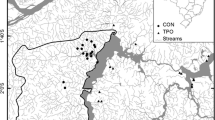Abstract
Aquatic insect assemblages were sampled in 2 sets of 18 small lakes in 2 regions of northeastern Ontario. Both sets included lakes with and without fish. In the set near Sudbury, fishless lakes were acidic. Using a standardized sweep net procedure, fishless lakes in both areas were found to have a greater abundance and richness of insects than lakes with fish. Irrespective of pH, fishless lakes supported a similar aquatic insect assemblage which was characterized by an abundance of nekton, especially Notonectidae, Corixidae, Graphoderus liberus (Dytiscidae) and Chaoborus americanus (Chaoboridae). Those taxa were typically absent from lakes with fish, which often had a marked abundance of Gerridae. It is concluded that fish predation is the most immediate factor structuring such aquatic insect assemblages, and is responsible for their change coincident with lake acidification.
Similar content being viewed by others
References
Beamish, R. J. & H. H. Harvey, 1972. Acidification of the La Cloche Mountain Lakes, Ontario, and resulting fish mortalities. J. Fish. Res. Bd Can. 29: 1131–1143.
Brooks, J. L., 1968. The effects of prey size selection by lake planktivores. Syst. Zool. 17: 273–291.
Brooks, J. L. & S. I. Dodson, 1965. Predation, body size, and composition of plankton. Science 150: 28–35.
Eriksson, M. O. G., 1979. Competition between freshwater fish and goldeneyes Bucephala clangula (L.) for common prey. Oecologia 41: 99–107.
Eriksson, M. O. G., L. Henrikson, B.-I. Nilsson, G. Nyman, H. C. Oscarson, A. E. Stenson & K. Larsson, 1980. Predator-prey relations important for the biotic changes in acidified lakes. Ambio 9: 248–249.
Galbraith, M. G., 1967. Size-selective predation on Daphnia by rainbow trout and yellow perch. Trans. am. Fish. Soc. 96: 1–10.
Harvey, H. H., 1975. Fish populations in a large group of acid-stressed lakes. Verh. int. Ver. Limnol. 19: 2406–2417.
Henrikson, L. & H. G. Oscarson, 1978. Fish predation limiting abundance and distribution of Glaenocorisa p. propinqua. Oikos 31: 102–105.
Hill, M. O., 1973. Reciprocal averaging: an eigenvector method of ordination. J. Ecol. 61: 237–249.
Hill, M. O., 1979a. TWINSPAN — A FORTRAN program for arranging multivariate data in an ordered two-way table by classification of the individuals and attributes. Ecology and Systematics, Cornell University, Ithaca, New York, 90 pp.
Hill, M. O., 1979b. DECORANA — A FORTRAN program for detrended correspondence analysis and reciprocal averaging. Ecology and Systematics, Cornell University, Ithaca, New York, 52 pp.
Hill, M. O. & H. G. Gauch, 1980. Detrended correspondence analysis: an improved ordination technique. Vegetatio 42: 47–58.
Hrbacek, J., M. Dvorakova, V. Korinek & L. Prochazkova, 1961. Demonstration of the effect of the fish stock on the species composition of zooplankton and the intensity of metabolism of the whole plankton association. Verh. int. Ver. Limnol. 14: 192–195.
Hurlbert, S. H. & M. S. Mulla, 1981. Impacts of mosquitofish (Gambusia affinis) predation on plankton communities. Hydrobiologia 83: 125–151.
Hutchinson, G. E., 1959. Homage to Santa Rosalia or why are there so many kinds of animals? Am. Nat. 93: 145–159.
Istock, C. A., 1973. Population characteristics of a species ensemble of waterboatmen (Corixidae). Ecology 54: 535–544.
Jeffries, D. S., 1984. Atmospheric deposition of pollutants in the Sudbury area. In J. O. Nriagu (ed.), Environmental impacts of smelters. John Wiley & Sons, New York: 117–154.
Macan, T. T., 1965. Predation as a factor in the ecology of water bugs. J. anim. Ecol. 34: 691–698.
Mackey, A. P., D. A. Cooling & A. D. Berrie, 1984. An evaluation of sampling strategies for qualitative surveys of macroinvertebrates in rivers, using pond nets. J. appl. Ecol. 21: 515–534.
Mossberg, P. & P. Nyberg, 1979. Bottom fauna of small acid forest lakes. Institute of Freshwater Research, Drottningholm, Sweden, Report No. 58: 77–87.
Muniz, I. P., H. M. Seip & I. H. Sevaldrud, 1981. Relationship between fish population and pH for lakes in southern Norway. Wat. Air Soil Pollut. 23: 97–113.
Northcote, T. G., C. J. Walters & J. M. B. Hume, 1978. Initial impacts of experimental fish introductions on the macrozooplankton of small oligotrophic lakes. Verh. int. Ver. Limnol. 20: 2003–2012.
Pope, G. F., J. C. H. Carter & G. Power, 1973. The influence of fish on the distribution of Chaoborus spp. (Diptera) and density of larvae in the Matamek River System, Quebec. Trans. am. Fish. Soc. 102: 707–714.
Post, J. R. & D. Cucin, 1984. Changes in the benthic community of a small precambrian lake following the introduction of yellow perch, Perca flavescens. Can. J. Fish. aquat. Sci. 41: 1496–1501.
Schofield, C. L., 1976. Acid precipitation: effects on fish. Ambio 5: 228–230.
Stenson, J. A. E., 1978. Differential predation by fish on two species of Chaoborus (Diptera, Chaoboridae). Oikos 31: 98–101.
Tonn, W. M. & J. J. Magnuson, 1982. Patterns in the species composition and richness of fish assemblages in northern Wisconsin lakes. Ecology 63: 1149–1166.
von Ende, C. N., 1979. Fish predation, interspecific predation, and the distribution of two Chaoborus species. Ecology 60: 119–128.
Weir, J. S., 1972. Diversity and abundance of aquatic insects reduced by introduction of the fish Clarias gariepinus to pools in central Africa. Biol. Conser. 4: 169–175.
Wells, L., 1970. Effects of alewife predation on zooplankton populations in Lake Michigan. Limnol. Oceanogr. 15: 556–565.
Werner, E. E. & D. J. Hall, 1974. Optimal foraging and the size selection of prey by the bluegill sunfish (Lepomis macrochirus). Ecology 55: 1042–1052.
Yan, N. D., R. W. Nero, W. Keller & D. C. Lasenby, 1985. Are Chaoborus larvae more abundant in acidified than in non-acidified lakes in central Canada. Holarct. Ecol. 8: 93–99.
Zaret, T. M., 1980. Predation and freshwater communities. Yale University Press, New Haven, 187 pp.
Author information
Authors and Affiliations
Rights and permissions
About this article
Cite this article
Bendell, B.E., McNicol, D.K. Fish predation, lake acidity and the composition of aquatic insect assemblages. Hydrobiologia 150, 193–202 (1987). https://doi.org/10.1007/BF00008703
Received:
Revised:
Accepted:
Issue Date:
DOI: https://doi.org/10.1007/BF00008703




